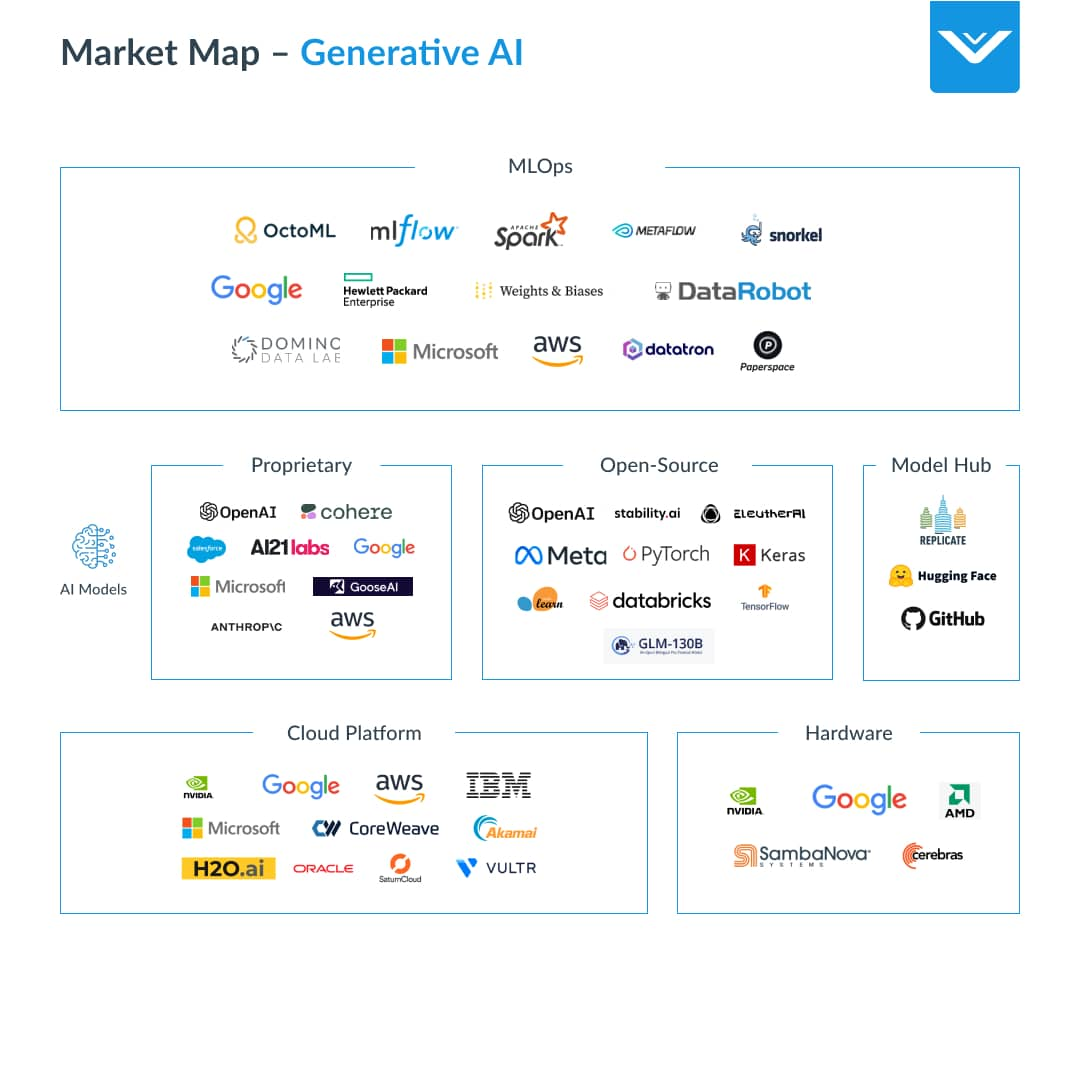Understanding the Generative AI Tech Stack
The recent acceleration in the mainstream adoption, integration, and advancement of generative AI technologies represents one of the most important, disruptive, and transformative technological events in the modern digital world. Businesses of all sizes across various industries are scrambling to identify opportunities and the means to incorporate the technology in and across their business functions. In doing so, many leaders and executives find growing value in building their own internal solutions and systems tailored to their internal functions and processes.
Businesses that understand the intricacies and underpinning technologies behind generative AI and can capitalize on available tools to craft specific solutions to their unique business problems, processes, and needs will be well-poised to make leaps and bounds regarding operational efficiency and competitive positioning.
What is Generative AI?
Generative AI is a form of artificial intelligence and machine learning technology that learns from existing data to generate new content, often with the guidance and direction of human input. Depending on the underlying generative architecture, foundational models are trained on massive amounts of data using machine learning techniques, including neural networks, to understand patterns, statistical distributions, contextual relationships, etc. – knowledge that is then used to generate new content.
This intricate learning process equips the model to produce new content, remarkably similar to the original data it was trained on, yet uniquely its own. Whether writing an article, composing music, creating a graphic design, or even generating code, generative AI can mimic human creativity in diverse domains with incredible results.
With the incorporation of Natural Language Processing (NLP), generative AI transcends the boundaries of mere content generation. It facilitates a user-friendly interaction, allowing users to communicate with the AI in natural, everyday language. By understanding and responding to user prompts, these models can automate various business functions, create new content, and even aid decision-making processes.
Why is Generative AI Important for Businesses?
Generative AI technology is one of the most critical emerging technologies available to businesses in recent history. At its core, generative AI enhances enterprises’ capability to streamline operations and customer interactions, thereby driving better business outcomes. The power of this technology lies in its ability to automate tasks, process massive and complex data volumes, generate insights, and enable predictive decision-making. This optimizes business performance and creates unprecedented opportunities for innovation and growth.
One of the most compelling applications of generative AI is its capacity to transform the customer experience. Businesses can deliver superior, tailor-made customer journeys by enabling hyper-personalization, real-time support, and intuitive product recommendations. This fosters customer loyalty, enhances engagement, and can lead to an increase in conversion rates.

On the operational front, generative AI allows businesses to automate routine tasks, augment data analysis, and enhance risk management. This bolsters operational efficiency and frees up human resources to focus on strategic and creative tasks. Whether automating content and image generation, augmenting data for machine learning models, detecting fraudulent activities, or predicting future trends, generative AI equips businesses with the tools to thrive in a data-driven era.
Businesses that adopt and effectively implement generative AI stand to gain a significant advantage in terms of competitive positioning. It allows them to stay ahead of the curve by enabling faster decision-making, innovative offerings, and efficient operations. With the pace of digital transformation only set to increase, businesses that harness the power of generative AI are well-positioned to lead their industries.
Business Applications and Benefits of Generative AI
Although the field of generative AI is in a state of constant evolution and advancement, the following represent some of the primary use cases and applications of generative AI technology by businesses and organizations. The following set of potential generative AI business applications, in addition to their specific benefits, are all designed to improve business operational efficiency, expand organizational capacity and resources, and delivery greater business effectiveness.
Content Generation:
Among the various facets of generative AI, content generation represents a game-changing application. Automation of text generation empowers businesses to produce high volumes of content spanning different types and formats with significantly enhanced speed and efficiency. This results in a content production pipeline that is faster, more cost-effective, and less prone to the limitations and inconsistencies of manual processes.
The ability to generate diverse content forms, from articles and blog posts to digital designs and social media posts, positions generative AI as a versatile tool in the content management arsenal of businesses. Whether it’s creating captivating blog posts that resonate with a business’s target audience, crafting compelling product descriptions that convert viewers into customers, or designing attractive social media posts that increase engagement, generative AI’s capabilities for creating content itself are vast.

Generative AI eliminates the bottleneck of time and human resource constraints in content creation. It enables businesses to consistently generate high-quality content, even at a large scale, reducing dependence on content teams and freeing up their time for higher-order tasks. This efficiency can enhance overall productivity, maintain a steady flow of fresh content, and keep audiences engaged.
Also noteworthy is the capacity of generative AI to mine raw data and create personalized content. Harnessing data and using machine learning from user interactions can tailor content to individual user preferences, leading to more targeted and effective communication strategies. The result is an improved customer experience, better engagement, and potentially higher conversion rates.
Customer Experience:
In customer experience, generative AI has ushered in a new era of personalized customer service chatbots and seamless interactions. Businesses can harness this technology to tailor their services unique to each customer, ensuring maximum satisfaction and fostering long-term relationships.
In this regard, one of the most impactful applications of generative AI is sales and customer support coaching and augmentation. Generative AI can provide insightful suggestions and predictive models to guide sales and customer support representatives by analyzing vast volumes of data, including past interactions. This not only optimizes the quality of interaction with customers but also empowers the staff with critical data-driven insights. For example, it can suggest the best possible solution to a customer complaint based on previous successful resolutions or guide a sales representative on the most effective approach to convert a lead.
Generative AI plays a critical role in the development of advanced conversational chatbots. These chatbots can interact with customers in a natural, human-like manner, answering queries, solving issues, or even conducting sales conversations 24/7. With the ability to learn from each interaction, these chatbots continually improve communication, ensuring a consistently superior customer experience. This reduces wait times, swift resolutions, and round-the-clock assistance, thus significantly enhancing the overall customer experience.
Compliance and Risk Management:
Generative AI offers a new dimension to managing compliance and risk within businesses, enhancing situational awareness and strategic positioning. It provides the ability to continually monitor vast amounts of data, identifying patterns and trends that could signify potential compliance or risk issues. This constant vigilance can alert organizations to emerging issues before they become significant problems, allowing for proactive risk management.
In specific industries, such as the financial sector, generative AI’s potential for risk management is particularly significant. It can be programmed to recognize the signs of fraudulent activity or potential money laundering operations, automatically flagging suspicious transactions for further investigation. This real-time monitoring can significantly reduce the time to detect and respond to such threats, limiting potential damage and maintaining a reputation.
Data Augmentation:
Generative AI is a powerful tool for augmenting datasets, a process especially beneficial for machine learning applications. Creating synthetic data that closely mirror real-world data expands existing datasets, enhancing the diversity and volume of training data available for machine learning models to train on. This increases the models’ predictive accuracy and overall performance.

The utility of synthetic data for augmentation of enterprise data extends across various domains, including healthcare, autonomous vehicles, and e-commerce, among others. For example, synthetic data can be generated in healthcare to supplement clinical trial data, leading to more robust and comprehensive predictive models for patient outcomes. In autonomous vehicle training, synthetic images can help the model better understand diverse road scenarios, thus improving decision-making abilities.
Predictive Analytics:
Generative AI serves as a transformative asset for predictive analytics, enabling businesses to forecast sales, manage inventory, plan budgets, and make strategic decisions with unprecedented accuracy. By analyzing historical data and identifying trends, AI models can predict future outcomes and trends, allowing businesses to plan and strategize effectively.
In specialized fields like healthcare, predictive analytics powered by generative AI can lead to groundbreaking advances. For instance, it can accelerate the drug discovery process by predicting the effectiveness of potential drugs, improve patient outcomes through predictive diagnostics, and optimize treatment plans by foreseeing possible complications. These AI-driven predictions can significantly enhance efficiency, reduce costs, and save lives.
Cybersecurity:
In the critical field of cybersecurity, generative AI offers a robust line of defense. It can analyze network traffic and system activities, identifying real-time anomalies and potential threats. This proactive approach to threat detection allows businesses to respond to vulnerabilities before they can be exploited, reinforcing their cybersecurity postures.
Generative AI can also help manage the enormous volume of alerts typically generated in security operations centers by distinguishing between false alarms and genuine threats. This reduces the burden on cybersecurity teams, allowing them to focus on high-priority issues. In addition, AI can help predict and mitigate future threats, providing a forward-thinking approach to cybersecurity.
DevOps:
In DevOps, generative AI streamlines and enhances various processes, from code generation to software testing. It can automate repetitive coding tasks, reducing the chance of human error and freeing developers to focus on more complex problems. Additionally, it can provide real-time suggestions during coding, detecting errors, and offering solutions on the fly.
Generative AI also aids in software testing and debugging, making the process more efficient and reliable. It can generate test cases based on the software’s specifications and use AI to identify potential bugs or performance issues. This leads to faster development cycles, higher-quality software code, and better products and services.
What are the Layers of the Generative AI Technology Stack?
Many organizations have been exploring the path of building their own generative AI technology, allowing for solutions specifically designed for and tailored to their data, customers, and business. However, one of the first steps is understanding the AI technology stack to craft an effective and internally aligned solution.

Layer 1: Hardware
The generative AI technology stack begins with the underlying computer hardware specifically designed to handle the computational demands of AI workloads. Graphics processing units (GPUs) have played a crucial role in powering deep learning models by accelerating the training and inference processes. GPUs excel at parallel processing, making them ideal for training generative AI models, which often involve complex computations. Alongside GPUs, other AI-specialized silicon and chips, such as Google’s Tensor Processing Units (TPUs), provide for model training and operation.
Layer 2: Cloud
Sitting above the hardware layer is the cloud platform layer, which offers scalable infrastructure and services designed to simplify the development, training, and deployment process. Cloud platforms provide organizations with the computing power and storage necessary to process and run AI functions and services at this layer. Alongside providing the needed power and storage, cloud platforms may offer additional supportive infrastructure, services, frameworks, and resources, as well as capabilities tailored to specific industries, all designed to enable improved model development, deployment, and operation.
Layer 3: Model
The model, trained on large amounts of data and capturing patterns and contextual understanding, forms the core layer of the generative AI technology stack. It is a starting point for businesses to build upon and customize according to their specific requirements. The foundational model can be proprietary or sourced from open-source repositories and model hubs.
Models can be further classified into general models, specialized models, which are fine-tuned for specific purposes and trained on specific content, and hyperlocal models, which are specialized models tailored for specific domains.
Layer 4: MLOps
Beyond the model layer is the MLOps layer, which encompasses the technologies, tools, and workflows used to optimize, train, and refine generative AI models. This layer is mainly responsible for efficiently managing the model development lifecycle, including tooling, model versioning, experimentation, and training. MLOps solutions, which can come in different forms with different tools and functionalities, can be utilized to refine models further to create focused and differentiated capabilities aligned with the specific needs and functions of the business.
How do I Build Generative AI Models?
Businesses can leverage the tools and solutions available to craft their internal model and applications by focusing on these four primary layers of the generative AI technology stack. In doing so, they can design for functionality, processes, and considerations specific to their industry and individual businesses. The following represents a company’s primary steps to effectively develop, deploy, and manage internal and custom-built generative AI solutions.
Step 1: Objective and System Mapping
Begin by defining objectives and use cases. As part of this step, assess data availability and quality to inform and determine infrastructure requirements. Ensuring a clear roadmap of specific use cases, functions, and requirements, with executive-level support, will ensure a streamlined, efficient, and effective approach to development, deployment, and management. Focus on automating simple and repetitive tasks while augmenting and assisting workers with more complex activities. Furthermore, maintain awareness around limiting the accumulation of technical debt and maintaining a high degree of flexibility for future adjustment.
Step 2: Building the Infrastructure
Based on identified use cases and internal environment assessments, select the appropriate hardware and cloud platform to provide the computing, storage, and scaling infrastructure necessary to deploy and manage the solution. At this stage, it’s critically important to ensure technical alignment, compatibility, and the selected infrastructure suitable for the identified use cases and objectives. In choosing the appropriate hardware and service providers, seek solutions that are comprised of products and services tailored to your specific use case and industry to facilitate greater functionality, alignment, and effectiveness.
Step 3: Model Selection
Selecting the foundational model is one of the most critical steps in building an internal generative AI solution. Considering the business objectives, use cases, and infrastructure and system capabilities, choose a model most aligned with the business and industry and afford customization and tailoring. Open-source solutions represent a compelling option allowing greater flexibility, adaptability, and functional development compared to proprietary models. This route may afford greater internal build and development control, ensuring a more effective outcome.

At this stage, it’s also important to consider the need for integrations, connectivity, and the specificity of the model’s intended function. If multiple data sources, internal and external, are to be used in training and management, ensure that the selected solution possesses extensive capability in integrating and processing various types and data sources. Depending on the functions and objectives, models may conduct general tasks, serve as a specialist model, or operate as a hyperlocal solution, which will further inform appropriate model and framework selection.
Step 4: Training and Refinement
Next comes the training and refinement of the foundational model. At this point, you’ll want to identify the MLOps solutions and tooling technologies to best develop and manage the model in completing the desired business functions and objectives. Similar to model selection, although large and established players offer proprietary solutions, there are also open-source options that provide greater flexibility and internal tailoring. There are also industry-specific MLOps platforms and training tools available, as well as general solutions, which can possess specific functionality and data connectivity to further enhance the effectiveness of use cases designed for specific industry activities (i.e., healthcare). Regardless of build or focus, select the tools that will best train and align the model with the intended functions and objectives while allowing for future expansion, integration, and adaptability.
Step 5: Training, Governance, and Iteration
With a generative AI technology stack in place that is tailored to internal business operations, the final step involves ensuring that employees are adequately trained on using and understanding the technology, that a technological governance structure is in place, and that model engagement and refinement continue. This step is essential in preventing misuse, abuse, bias, and negative externalities while ensuring the technology remains aligned with business objectives and adaptable to changing internal and external landscapes.
Navigating the evolving complexity of the innovation and technology landscape can be daunting. Vation Ventures can serve as your valued partner in your business journey through tailored market, technology, and competitive insights provided through our Research as a Service or through our sparkLAB, a program designed to help CXOs identify and solve complex business problems using innovative technology. Get in touch today.




